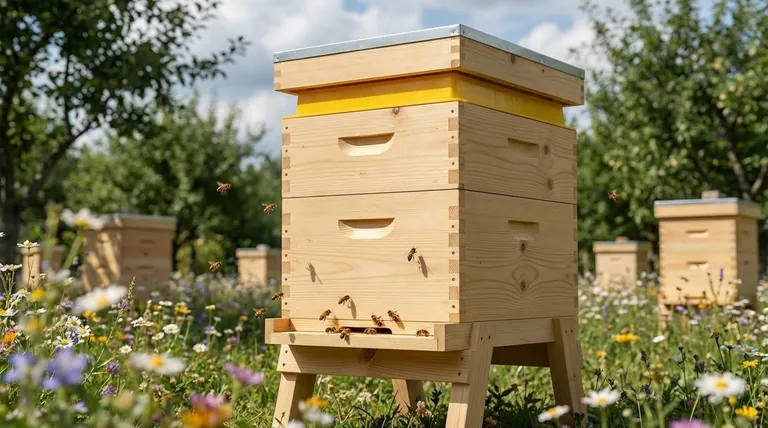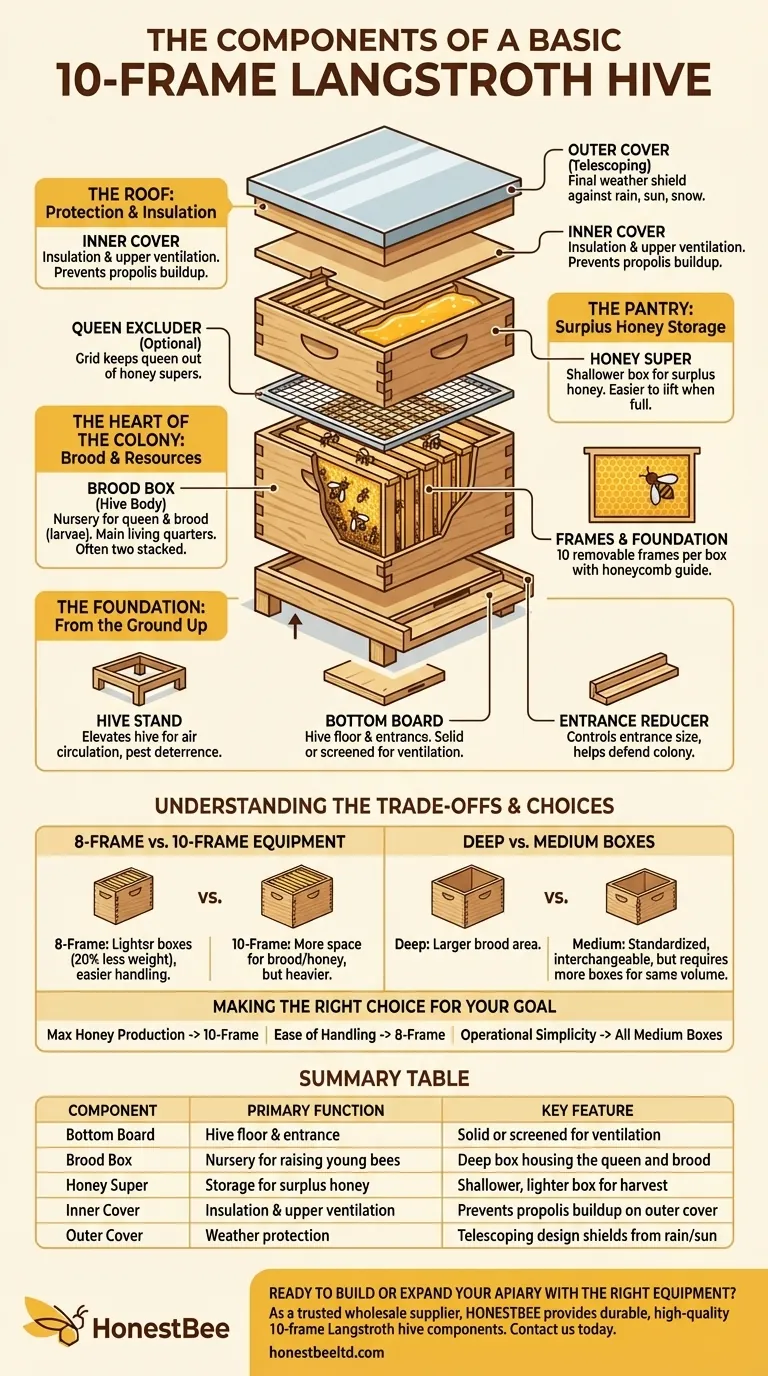A standard 10-frame Langstroth hive is a modular system composed of several key parts stacked vertically. The essential components, from bottom to top, include a bottom board, a deep box for the brood chamber, shallower boxes called "supers" for honey storage, an inner cover, and a protective outer cover. Each box is filled with removable frames, which are the hive's defining innovation.
The Langstroth hive is designed as an integrated system, not just a collection of boxes. Each component serves a specific function to provide a secure, expandable, and easily managed environment that meets the colony's needs while allowing for efficient honey harvesting.

The Foundation: From the Ground Up
The bottom of the hive provides the entrance and structural base for the entire colony.
The Hive Stand
A hive stand is an optional but highly recommended base that elevates the entire hive off the ground. This simple act improves air circulation, deters pests like skunks, and reduces moisture absorption from the ground, contributing to a healthier colony.
The Bottom Board
The bottom board serves as the floor of the hive. It provides the primary entrance and landing pad for foraging bees. You will typically choose between a solid bottom board or a screened one, which offers better ventilation and helps in monitoring Varroa mite levels.
The Entrance reducer
This is a small, cleat-like piece of wood used to control the size of the hive's main entrance. It is critical for helping a new or small colony defend itself from robber bees and for regulating temperature during colder months.
The Heart of the Colony: Brood and Resources
This is the main living area of the hive, where the queen lays eggs and the colony raises its young.
The Brood Box (Hive Body)
The brood box, also called a hive body, is the large, deep box that sits directly on the bottom board. This is the nursery and main living quarters of the colony. It's where the queen lays her eggs, and the worker bees raise the developing larvae (the brood). A thriving colony will often require two brood boxes stacked on top of each other.
Frames and Foundation
Inside every brood box and super are 10 removable frames. Each frame holds a sheet of foundation, typically made of beeswax or plastic, which is imprinted with a honeycomb pattern. This foundation provides a guide for the bees to build their wax honeycomb, where they will raise brood and store honey and pollen.
The Pantry: Surplus Honey Storage
These components are focused on the collection and harvest of honey.
The Queen Excluder (Optional)
A queen excluder is a flat grid of wire or plastic placed between the top brood box and the honey supers. The openings are large enough for worker bees to pass through but too small for the larger queen. This ensures that no eggs are laid in the honey supers, keeping the harvest free of brood.
The Honey Super
A "super" is simply any box placed above the brood chamber for the purpose of storing surplus honey. These boxes are typically shallower and therefore lighter than brood boxes, making them much easier to lift when they are full of heavy honey. They come in medium ("Illinois") or shallow depths.
The Roof: Protection and Insulation
The top layers of the hive protect the colony from the elements.
The Inner Cover
The inner cover is a flat board that sits directly on top of the uppermost box. It creates an insulating dead air space, provides an upper entrance or ventilation point via a small notch, and prevents the bees from gluing the outer cover to the hive body with propolis.
The Outer Cover
This is the final roof of the hive. Often called a telescoping cover, its sides hang down over the top of the hive, providing excellent protection from rain, snow, and direct sun. It is the colony's primary shield against the weather.
Understanding the Trade-offs
The modularity of the Langstroth system presents choices, each with different implications for hive management.
8-Frame vs. 10-Frame Equipment
While you asked about the 10-frame standard, an 8-frame version is a very common alternative. A 10-frame hive offers more space for brood and honey, but its boxes become extremely heavy when full. An 8-frame hive is narrower and its boxes are significantly lighter, making it a better choice for beekeepers with physical limitations.
Deep vs. Medium Boxes
A deep box provides a large, uninterrupted area for the queen to lay eggs, which many beekeepers prefer for the brood nest. However, some beekeepers choose to standardize their entire operation on medium-depth boxes for both brood and honey. This simplifies equipment management, as every box and frame is interchangeable. The trade-off is that you will need more boxes to equal the same volume.
Making the Right Choice for Your Goal
As you assemble your hive, your choice of components should be guided by your specific objectives as a beekeeper.
- If your primary focus is maximizing honey production: A 10-frame hive offers the most space for a large colony to store surplus honey, but be prepared for heavy lifting.
- If your primary focus is ease of handling: An 8-frame hive is a superior choice, as every box you lift will be around 20% lighter than its 10-frame equivalent.
- If your primary focus is operational simplicity: Standardizing on all medium-depth boxes for both brood and honey means every piece of equipment is interchangeable.
Understanding the role of each component transforms you from someone who just owns a beehive into a beekeeper who can effectively manage a thriving colony.
Summary Table:
| Component | Primary Function | Key Feature |
|---|---|---|
| Bottom Board | Hive floor & entrance | Solid or screened for ventilation |
| Brood Box | Nursery for raising young bees | Deep box housing the queen and brood |
| Honey Super | Storage for surplus honey | Shallower, lighter box for harvest |
| Inner Cover | Insulation & upper ventilation | Prevents propolis buildup on outer cover |
| Outer Cover | Weather protection | Telescoping design shields from rain/sun |
Ready to build or expand your apiary with the right equipment?
As a trusted wholesale supplier to commercial apiaries and beekeeping equipment distributors, HONESTBEE provides durable, high-quality 10-frame Langstroth hive components designed for productivity and ease of management. Our products help you establish and maintain thriving colonies for maximum honey production or simplified hive handling.
Contact HONESTBEE today to discuss your wholesale needs and get a quote on our full range of beekeeping supplies and equipment.
Visual Guide

Related Products
- Professional Hive Top Bee Feeder for Beekeeping
- Telescopic Beehive Outer Cover Lid Roof with Galvanised Sheeting for Langstroth Hive and Beehive Outer Cover
- Ergonomic Two Person Foldable Hive Lifter
- Professional Galvanized Hive Strap with Secure Locking Buckle for Beekeeping
- Professional Dual-End Stainless Steel Hive Tool for Beekeeping
People Also Ask
- What is a top feeder for bees? Maximize Colony Health with Efficient Feeding
- What is the best bee feeder for a hive? Choose the Right Feeder for Your Apiary's Scale
- What are the features of top feeders for bees? Maximize Hive Health with Safe, High-Capacity Feeding
- How to use a top feeder in a beehive? A Guide to Effective Beehive Feeding
- What are the advantages of using top feeders for bees? Maximize Feeding Efficiency & Colony Safety



















